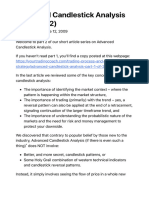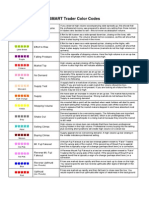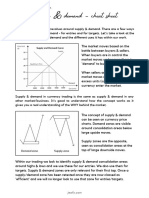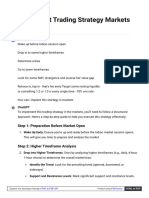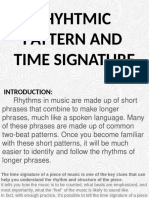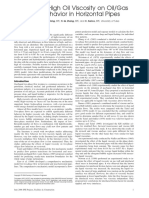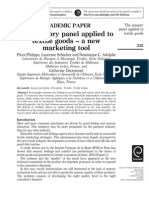Volume Analysis
Volume Analysis
Uploaded by
amar_pmishra4590Copyright:
Available Formats
Volume Analysis
Volume Analysis
Uploaded by
amar_pmishra4590Copyright
Available Formats
Share this document
Did you find this document useful?
Is this content inappropriate?
Copyright:
Available Formats
Volume Analysis
Volume Analysis
Uploaded by
amar_pmishra4590Copyright:
Available Formats
Vision Books
How trading volumes reveal the market’s market
By Joel G. Siegel, Jae K. Shim, Anique Qureshi, Jeffrey Brauchler
Sunday, 03 December , 2006, 12:59
The number of shares of stock, bonds, options, or futures contracts traded over a
designated period (e.g., daily, weekly, monthly). Advancing volume is the total
volume for all stocks increasing in price; declining volume is the total for all stocks
decreasing in price. To remove variability elements it may be advisable to smooth
this measure with a moving average (e.g., 5 days).
Volume reflects the intensity (strength) of a stock or commodity. Volume also
provides an indication of the quality of a price trend and the liquidity of a security
or commodity. High volume means greater reliance can be placed on the
movement in price than if there was low volume, because heavy volume is the
relative consensus of a large number of participants. High volume indicates an
active market; in an active market, the spread between bid and asked prices is
usually narrower.
High volume is often characteristic of the initial stage in a new trend, such as a
breakout in a trading range. Before a market bottom, investor nervousness leads
to panic selling, a characteristic of which is high volume. High volume is also
attributable to a market top when strong buyer interest exists.
Low volume often exists during an unsettled period, such as at a market bottom.
Low volume reflects a lack of confidence that is usually indicative of a
consolidation period when prices are within a sideways trading range.
A sizable increase in volume may point to a breakout (start) or climax
(culmination) of a move, which may be temporary or final. In a rare case, it may
represent a shakeout.
Volume typically follows a trend, expanding on rallies and decreasing on
reactions. Volume indicators are more reliable if formulated from a smoothed rate
of change (ROC) or smoothed trend deviation. Volume is useful in ascertaining
how strong a change in expectations really is.
It is important to look at the relationship between volume and price. A price move,
up or down, that is on higher volume is more significant. Therefore, an analysis of
price and volume allows the investor to better interpret the trends in price and any
changes thereto. In other words, volume gives an indication of the strength
(momentum) of a move in price.
Current trading volume and average trading volume should be compared.
(Average daily trading volume for many stocks is published monthly by the Wall
Street Journal). Average trading volume typically decreases when a stock is in a
downtrend, because investors view negatively a stock declining in price. An
increasing price is typically coupled with increased volume, but the price can
decrease without an increase in volume if investors lose interest in the issue. On
the other hand, a declining stock price may be coupled with higher volume when,
for example, negative news comes out about the company.
The significance of a change in volume is related to the associated price trend or
pattern. For example, a good time to buy stock is when there are simultaneous
price and volume increases. Table 1 provides general rules for volume analysis.
Volume should be evaluated in appraising market strength or weakness. If
volume is increasing, whether prices are going up or down, it is probable that
prices will continue their current trend. However, if volume is decreasing, the
current trend will probably not continue and a reversal may be imminent.
A strong uptrend usually has more volume on the upward legs; similarly, a strong
downtrend will have more volume on the downward legs. After the trend ends the
corrective leg usually has lower volume. A downtrend may nevertheless be
extended whether average trading volume increases, decreases, or is static.
Volume is relative in that it usually is greater approaching the top of a bull market
than near the bottom of a bear market. Further, trading volume typically increases
and continues higher than average in an uptrend, but is below average during a
downtrend.
Trading volume typically goes up as the price breaks out to the upside of a
pattern or formation. In this case, a significant increase in volume is a strong buy
signal. However, volume is an indicator of a trend reversal if it goes in a direction
contrary to a prevailing trend.
Volume/price analysis, on balance volume, upside/downside volume ratio and
line, volume up days/volume down days, cumulative volume index, trade volume
index, positive volume index, and volume reversal are among the ways volume
can be analyzed.
You might also like
- 6th Central Pay Commission Salary Calculator100% (436)6th Central Pay Commission Salary Calculator15 pages
- Advanced Candlestick Analysis (Part 2 of 2)No ratings yetAdvanced Candlestick Analysis (Part 2 of 2)14 pages
- Training Architecture ORAN-WG2.UsecaseRequirements.v01.00 PDFNo ratings yetTraining Architecture ORAN-WG2.UsecaseRequirements.v01.00 PDF29 pages
- Accumulation Distribution Uses Volume To Confirm Price Trends or Warn of Weak Movements That Could Result in A Price ReversalNo ratings yetAccumulation Distribution Uses Volume To Confirm Price Trends or Warn of Weak Movements That Could Result in A Price Reversal2 pages
- CHAPTER 7 - Basic Characteristic of VolumeNo ratings yetCHAPTER 7 - Basic Characteristic of Volume32 pages
- The Selling Climax Has A Widening Spread and Increasing Volume. If It Does Not HaveNo ratings yetThe Selling Climax Has A Widening Spread and Increasing Volume. If It Does Not Have5 pages
- The Price-Volume Behavior of An Equity: Theoretical ApproachNo ratings yetThe Price-Volume Behavior of An Equity: Theoretical Approach11 pages
- PDF Created With Pdffactory Trial VersionNo ratings yetPDF Created With Pdffactory Trial Version8 pages
- Game Plan: Scenario 1 - Highs Made First Unable To Break ResistanceNo ratings yetGame Plan: Scenario 1 - Highs Made First Unable To Break Resistance2 pages
- 9th Mentoring Program Day - 5 - 12th Oct 2022No ratings yet9th Mentoring Program Day - 5 - 12th Oct 202236 pages
- SMART Trader Color Codes: Absorption VolumeNo ratings yetSMART Trader Color Codes: Absorption Volume1 page
- Monitoring The Smart Money by Using On Balance Volume PDF100% (2)Monitoring The Smart Money by Using On Balance Volume PDF5 pages
- TDs Flexible Volume Profile InstructionsNo ratings yetTDs Flexible Volume Profile Instructions4 pages
- Volumatic Variable Index Dynamic Average [BigBeluga] — Indicator by BigBeluga — TradingViewNo ratings yetVolumatic Variable Index Dynamic Average [BigBeluga] — Indicator by BigBeluga — TradingView10 pages
- Better Than Candlestick Patterns - Part FiveNo ratings yetBetter Than Candlestick Patterns - Part Five6 pages
- How To Trade Triangles - A Step by Step Guide: What Is A Triangle Telling You?No ratings yetHow To Trade Triangles - A Step by Step Guide: What Is A Triangle Telling You?7 pages
- Chatgpt Com Share 887ecc44 191d 4bd9 A12a 4a2a5ba68c1bNo ratings yetChatgpt Com Share 887ecc44 191d 4bd9 A12a 4a2a5ba68c1b23 pages
- Vsa by Karthik Marar - Trendlines & Vsa - Part 19No ratings yetVsa by Karthik Marar - Trendlines & Vsa - Part 192 pages
- Accumulation Stage: Commercial Retail Locals Smart MoneyNo ratings yetAccumulation Stage: Commercial Retail Locals Smart Money3 pages
- NR7 Forex Trading Strategy: What Is The NR7 Pattern?No ratings yetNR7 Forex Trading Strategy: What Is The NR7 Pattern?5 pages
- An Autobiography or The Story of My Experiments With Truth100% (12)An Autobiography or The Story of My Experiments With Truth269 pages
- AMATORIO vs. YAP A.C. No. 5914 March 11, 2015No ratings yetAMATORIO vs. YAP A.C. No. 5914 March 11, 20151 page
- Paper 11-Critical Path Reduction of Distributed Arithmetic Based FIR FilterNo ratings yetPaper 11-Critical Path Reduction of Distributed Arithmetic Based FIR Filter8 pages
- Shapiro Company A Manufacturer of Small Tools Implemented LeanNo ratings yetShapiro Company A Manufacturer of Small Tools Implemented Lean1 page
- Daily-Lesson-Log - Science - Week7 - Monday and TuesdayNo ratings yetDaily-Lesson-Log - Science - Week7 - Monday and Tuesday4 pages
- Effect of Pipe Length On The Transition Boundaries For High ViscosityNo ratings yetEffect of Pipe Length On The Transition Boundaries For High Viscosity11 pages
- Systems Operation: Shutdown SIS Previous ScreenNo ratings yetSystems Operation: Shutdown SIS Previous Screen18 pages
- The Sensory Panel Applied To Textile Goods A New Marketing ToolNo ratings yetThe Sensory Panel Applied To Textile Goods A New Marketing Tool14 pages
- Baumol'S Theory of Sales Revenue Maximization: Dr. Anand.D.MulgundNo ratings yetBaumol'S Theory of Sales Revenue Maximization: Dr. Anand.D.Mulgund10 pages


